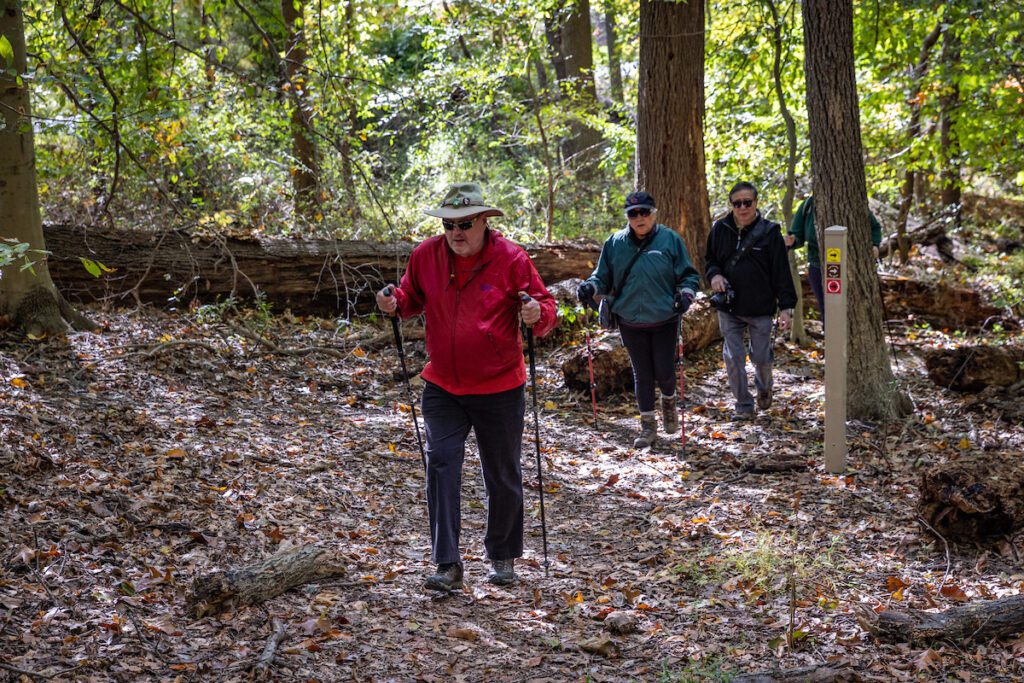
August 11, 2023
Managing trails is no walk in the park. By taking a few simple actions, we can all protect the parks we love and ensure that other park visitors enjoy their time outdoors. Follow the guidelines below next time you’re out in parks! Not sure where to explore next? Check out our Trails Page to search for your next adventure.

Know Before You Go
A major key to success for many outdoor activities is planning. Before hitting the trails this season, consider the following factors:
Trail Activities
Many of the trails in Delaware State Parks are multi-use. This means the multiple activities – from hiking to biking, horseback riding to pet walking – may be occurring all in the same space. Trails do not exist only for your use. They are community resources meant to be shared and enjoyed by all. Before hitting the trail, evaluate if the activity you plan to do is permitted on your selected trail and how other permitted activities might affect your plan.
Conditions
Every day is a good day to get outdoors, but not every day is a good day for every activity. Think about how local conditions might affect your plan or impact the health of the trail. For example: in rainy or muddy conditions, avoid using trails that are prone to mud. If you can leave a footprint, it’s too wet to use. Continuous trail use in muddy conditions damages the overall ecosystem and safety of the trail. Learn more about erosion in the next section.
Rules & Regulations
Parks may feel a little wild, but don’t let that fool you! Check out the rules and regulations that impact your activity, specifically subsections 12.0 and 14.0 of Title VII of the Delaware Administrative Code, found here. These two sections focus specifically on cycling, skating and equestrian uses of trails.

Stay on Marked Trails
Planning, Preservation and Development teams in the Division of Parks and Recreation go to great lengths to design, evaluate and ensure the safe use of trails within our parks – do them a solid and stay on marked trails! Anytime you leave a trail to get a better view, capture the perfect shot, or design your own “better” option, you risk causing damage to flora and fauna in the area and directly impact the future of our parks. Areas where vegetation no longer grows are more prone to erosion.
Think of plant roots like bones in the body – they add structure to shifting soil to create stability. When plants no longer grow in a space, the soil becomes unstable and is likely to erode with every foot, storm and wind. This is especially a problem for our fragile beach dunes, which face increased erosion from powerful storms, population increases and misuse by visitors. Protect our communities and the longevity of these natural spaces by staying on trails.

Don’t Be a Trail Hog
As visitation skyrockets in Delaware State Parks, our teams are experiencing more “user conflicts” (read: visitors disagreeing about how to share a space) than ever before. If we all educate ourselves on the basic tenets of using trails, we can make a big impact on people’s experiences in parks. At the most basic level, you should always:
Stay to the right
If you need to pass a slower moving party, make them aware that you are passing on the left. Use a bell or go lo-fi by just *politely* using your voice.
Yield correctly
1. Bikes yield to hikers, as they move slower and will need more time to get out of the way than bikers will.
2. People going downhill yield to people going uphill, because momentum. The folks moving uphill are already trying to hide their struggle from you, don’t make it worse. Give them space to conquer the few hills we have in this state – and better yet, cheer them on.
Be mindful of space & speed
1. Reduce your speed – on feet, horse or wheels – when in areas that are crowded or have blind spots.
2. Be aware of how much space your group is occupying on the trail. There should always be plenty of room for others to use the trail too – without asking you to move.
3. Think about the auditory space you occupy. Respect other’s desire for a quiet, natural experience by leaving speakers at home, lowering your voices, and opting for headphones when you do want to enjoy music (or that true crime podcast – we see you). If you wear headphones, make sure the sound is low enough that you can still hear hazards or other trail users to avoid calamity.
A little bit of preparedness and consideration goes a long way. Next time you enjoy trails in our parks and beyond, keep these guidelines top of mind.
This article is part of the Parks Better series, designed to help park visitors understand how to be good stewards of the parks we love. Check out other articles in this series, here.


